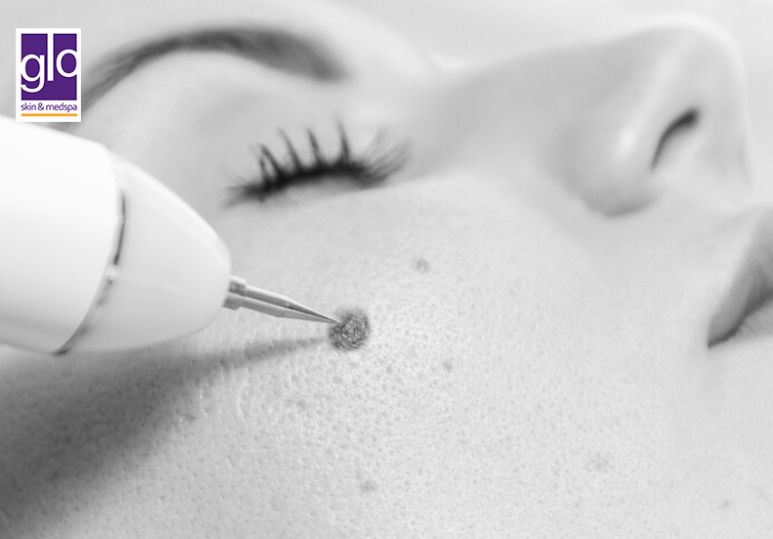Understanding Moles and Melanoma
A mole is a type of skin lesion that can appear anywhere on the body and is usually dark brown or black in colour. Moles are typically harmless and do not require any treatment, but if you have a mole you find unsightly or uncomfortable, you can address it with cosmetic mole removal treatment. Melanoma is a type of skin cancer that starts in cells called melanocytes and can spread to other parts of the body if left untreated. Often the first signs of melanoma are a change in the shape, colour, or size of an existing mole. Melanoma can also appear as a new mole. Suspicious moles should be removed by a dermatologist.
For tips on caring for your skin after cosmetic mole removal,
read Top Tips For Mole Removal Aftercare.
The ABCDEs of Melanoma
To spot the difference between a mole and melanoma, it is important to know the ABCDEs of melanoma. The ABCDEs of melanoma refer to the following signs and symptoms to help spot melanoma in its earliest stages:
A - Asymmetry: One half of the mole does not match the other.
B - Border: The borders of the mole are irregular and not well-defined.
C - Colour: The colour of the mole is not uniform and may have multiple shades of black, brown, pink, red, white, or blue.
D - Diameter: The diameter of the mole is larger than 6 millimetres (the size of a pencil eraser).
E - Evolving: The mole has changed in shape, size, or colour.
Keep in mind that not all melanomas will have all these signs, but if you notice any changes in a mole or skin lesion, it's important to see a dermatologist for a skin biopsy. Early detection and treatment of melanoma can greatly increase the chances of successful treatment and recovery.
Spotting the Differences in Colour and Texture
Another way to tell the difference between a mole and melanoma is by examining the colour and texture. Moles are typically uniform in colour, whereas melanomas are often multicoloured, with shades of black, brown, pink, red, white, or blue. Melanomas are also usually raised and have a rough or scaly texture, whereas moles are typically flat or slightly raised.
The Importance of Regular Skin Examinations
It is important to perform regular skin examinations to monitor any changes in your moles or skin lesions. If you notice any changes, such as a new lesion or a change in shape, size, or colour, book an appointment with your dermatologist, who may perform a skin biopsy to determine if the lesion is cancerous or not, and may recommend excision or surgical removal if necessary.
Protecting Your Skin from Sun Damage
One of the best ways to avoid the dangers of melanoma is to protect your skin from sun damage. This includes wearing protective clothing, using sunblock with a high SPF, and limiting your exposure to UV rays, especially between the hours of 10am and 4pm when the sun's harmful rays are the strongest.
Cosmetic Mole Removal At Glo Skin Medspa
When you understand the difference between normal moles and the indications of melanoma, you can make the most informed decisions about your skin care. If you suspect a mole might be cancerous, seek the advice of your primary care physician first. For normal mole removal, seek treatment from an experienced skin care specialist who will consider the size, depth, and location of the skin tag or mole. And use the most advanced technologies and removal methods to minimize any risk of scarring.
If you are seeking cosmetic mole removal our team at Glo Skin Medspa has the experience and expertise to answer any questions you may have. Our objective is to provide you with fast results while minimizing the risk of scarring. If you would like to learn more about our mole removal process please call (780) 481-9772 or book a free consultation.
** This article provides general information and discussions about skin health and related subjects. The information and other content provided in this and any linked materials are not intended to be used as a substitute for medical advice, diagnosis, or treatment. If you have a concern about a new skin growth or the changing appearance of a mole you should consult with your primary health care provider and seek professional medical treatment immediately. For more detailed information on melanoma please visit skincancer.org.**
FAQ
Q: What should I do if I think I have melanoma?
A: If you think you have melanoma, it is important to see a dermatologist for a skin biopsy. Your dermatologist will be able to determine if the lesion is cancerous or not and recommend excision or surgical removal if necessary. Early detection and treatment of melanoma can greatly increase the chances of successful treatment and recovery. You may need to seek a referral to a dermatologist from your family doctor.
Q: What can I do to reduce my risk of developing melanoma?
A: To reduce your risk of developing melanoma, protect your skin from sun damage by wearing protective clothing, using sunblock with a high SPF, and limiting your exposure to UV rays, especially between the hours of 10am and 4pm when the sun's rays are the strongest. Additionally, perform regular skin examinations to monitor any changes in your moles or skin lesions and seek prompt medical attention if you have any concerns.
Q: How long does a mole removal procedure take?
A: A mole removal process can take anywhere from 10 minutes to 1 hour depending on the size and depth of the mole. Stitches may remain for 2-4 weeks post-removal.



